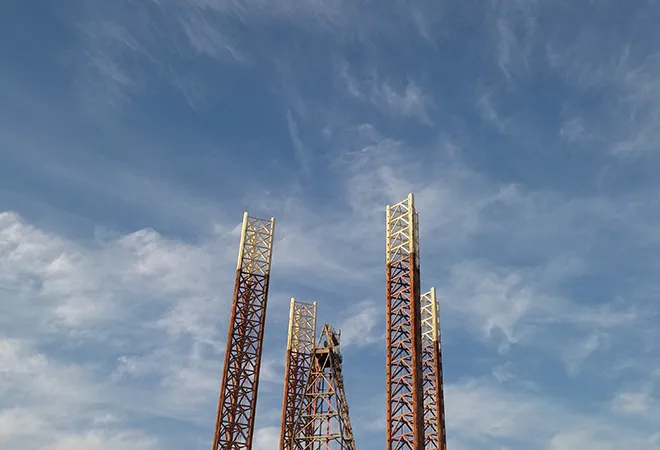-
CENTRES
Progammes & Centres
Location
A shortfall in the estimated collection of indirect taxes from lower GST accruals or from tax relief on petroleum products can upset the apple cart.

The government’s move to rationalise GST rates after the electoral losses in the three states is a welcome move. It needs to rationalise the punitive taxes on petroleum products or at least cap the taxes once the prices shoot up beyond Rs 70 per litre. Importantly, it needs to understand that whereas fiscal discipline is needed, it cannot put the entire burden on the voter. It must take steps to efficient spending of the tax payers’ money. Also, it has not done enough about resource generation. Its promised disinvestment programmes are just half-done jobs that need to be completed to ensure additional revenue generation.
The voter anger against the BJP was timely. It was a resounding negative vote, and a reminder to rectify its mistakes both politically and economically. With more than six months to go for the general elections, the government gets a chance to correct itself. That it is attempting to do so shows that it is responsive to voter anger. It is also a huge reason — why in large emerging economies like India — it is beneficial to be in a continuous electoral cycle and not have one nation and one poll system. A once in a five year decision to rule, and a free run to politicians to govern undeterred, unhindered for five years at a stretch, would cause undue hardship on the people.
The voter anger against the BJP was timely. It was a resounding negative vote, and a reminder to rectify its mistakes both politically and economically.
Here several policies like the GST are being continuously visited since the last one year, only because voter feedback at every poll says that the tax structure is too complicated and tax slabs too high.
There are several problems with the GST. One, that it has four basic slabs. No amount of industry representation with the previous Revenue Secretary Hasmukh Adhia could convince him of the fact that it was one too many. But the 2018 issue of ‘India Development Update’ of the World Bank says that comparatively 49 nations have a single tax rate and 28 nations have only two rates, 34 countries have three tax slabs and only four nations have four slabs. Besides, the 28% GST rate is punishingly high — the second highest in the world. It is surely unfair to pay more than a fourth of the revenue earned to indirect taxes for any business venture, even if the consumer pays for it.
However, it is not only the high tax rates and the number of slabs that are hurting the businesses. It is also the way it is structured. Like in the case of income tax, the GST must have a single page return format with few questions asked. You cannot burden an honest taxpayer with questions about his suppliers or his buyers and try to create a trail of evidence against the missing link in the supply chain. Though it is supposed to be a consumption tax, the GST is erroneously drafted to do just that. In trying to do that, it has made the filing of taxpayer returns unusually complicated.
The 28% GST rate is punishingly high — the second highest in the world. It is surely unfair to pay more than a fourth of the revenue earned to indirect taxes for any business venture, even if the consumer pays for it.
Let us see how it adversely affects the merchant exporter. Since exports have been traditionally exempted from high excise duties and sales tax, or received a duty drawback in the older tax system — it was expected that they would be similarly treated with soft gloves in GST. Unfortunately, that was not to be. Section 11 of the GST relates to the exemption of any goods sold from GST, which is mostly availed by merchant exporters. It is unusually complicated, especially in assessment of tax on composite goods in which an exporter buys from several manufacturers and exports a composite package or item to an overseas buyer. Here more than half a dozen rates from 0.5% to 14% are applicable for no conceivable reason or purpose. Besides, there are unusual compliance clauses that make a supplier responsible for an exporter consignment and his misrepresentation if any.
The BJP government was blessed by low international crude oil prices from 2014 to 2017. The cumulative crude oil imports from 2011 to 2014 by the Manmohan Singh government was $427 billion against the import bill of $247 billion during 2014-17 by the Narendra Modi government. The saving was a humongous at $180 billion, but the benefits were not passed on to people. Instead the Centre and State governments increased the excise duty and VAT to astronomical levels to divert gains to the exchequer. The people were not bothered initially as the international crude oil prices were low. Even after the punitive taxes, both petrol and diesel prices were well below Rs 70 per litre, for almost three years.
But during the summer of 2017, when international prices started firming up, the government remained adamant and refused to lower the taxes. At that time, product price of imported crude oil was only Rs 36 per litre, but with punishing duties that were over 100%, retail prices of petrol and diesel shot up to over Rs 75 per litre. The BJP government was in power not only at the Centre but also in 20 states at that time. It could have easily reduced the taxes, but refused to do so.
During the summer of 2017, when international prices started firming up, the government remained adamant and refused to lower the taxes. At that time, product price of imported crude oil was only Rs 36 per litre, but with punishing duties that were over 100%, retail prices of petrol and diesel shot up to over Rs 75 per litre.
For the next few months, crude oil prices kept rising and retail prices at the petrol pumps crossed Rs 80 per litre. Since both diesel and petrol prices skyrocketed, it hurt the farmer, the transporter and the commutator. Though some farmer groups protested, the society at large were quiet, but visibly angry. Perhaps because it was unfair to be taxed at 100%+ on a critical commodity that upset family budget both for both the rural as well as urban dweller. Voter anger came into play in the state elections of MP, Chattisgarh and Rajasthan that were held in the month of November 2018. This despite the fact that crude prices had started to soften once again.
The government claims that it does not want to bring back subsidies to petroleum products. That is not what is required. But what is urgent is capping of taxes whenever the retail price reaches Rs 70 per litre.
The government would be worried about revenue losses if farm loan waivers, GST cuts, petrol and diesel taxes are offered. Already November-end fiscal deficit has touched Rs 7.16 trillion, which is 15% higher than the budgeted estimate of 3.3% of GDP. With one quarter of the financial year still to cross, the government is already in a very tight position. A shortfall in the estimated collection of indirect taxes from lower GST accruals or from tax relief on petroleum products can further upset the apple cart.
A year after the Modi government came to power, it mooted the oil sector consolidation plan, but did not follow it up seriously.
However, it still has a few aces up its sleeve that it needs to use. Last year, the government pulled itself out of the hole by a last moment disinvestment move in the oil sector where ONGC bought 51.1% stake of HPCL for Rs 369.15 billion in late January 2018. With this, the government managed to keep the fiscal deficit pegged to 3.5% and the disinvestment figure exceeded by Rs 20,000 crore. But the oil sector consolidation is still incomplete. The ONGC chairman, when asked if the move would be followed up by the acquisition of MRPL, said: “That is a logical step. We see an advantage in that but cannot give a time frame.”
A year after the Modi government came to power, it mooted the oil sector consolidation plan, but did not follow it up seriously. All over the world, major players like Exxon Mobil, Shell, BP, Chevron or Total have integrated facilities of exploration, refining as well as marketing. Even the Saudi-based Aramco, Russia based Roseneft and Gazprom and China based Sinopec have consolidated their offerings. In India — IOC, HPCL and BP are refining and marketing companies, while OIL, ONGC and GAIL are the exploration units. The half a dozen Indian companies are much smaller entities that need to be consolidated in two or three units with integrated operations of exploration, refining and marketing. If that exercise happens now — the government can divest its stake in multiple units and also earn over Rs 1 trillion from the exercise.
The views expressed above belong to the author(s). ORF research and analyses now available on Telegram! Click here to access our curated content — blogs, longforms and interviews.

Sandip Sen is an author and journalist writing on a vast range of subjects from economy to technology environment to lifestyle. He is a regular ...
Read More +